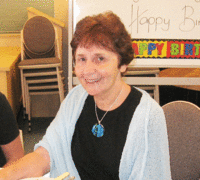Reflection
Veronica Lawson RSM
Luke 9:11-17
 The gospel for today brings together elements that have traditionally formed part of Christian worship. In the first part of the story, Jesus welcomes those who follow him.
The gospel for today brings together elements that have traditionally formed part of Christian worship. In the first part of the story, Jesus welcomes those who follow him.
He then speaks to them of God’s reign and heals those in need of healing.
In the second part, he takes the loaves, blesses them, breaks them and puts them before the disciples who distribute the bread to the assembled people. All eat and are satisfied.
The second part of the story is full of Eucharistic symbolism.
The setting is a ‘desert’ place, recalling the wanderings of the Israelites in the desert of Sinai. The hunger of the people recalls God’s care of Israel in the wilderness. God feeds God’s people in the deserts of life, but only if those called to be disciples recognise their responsibility to be the hands of God. ‘Send them away’ is one solution, clearly not the one preferred by Jesus. Rather, he says, ‘You give them something to eat’. When the people sit down in circles and share their food, they find there is more than enough for everyone.
Jesus’ actions and words over the bread [and the fish] are echoed in the account of his final meal with the disciples: the bread broken and shared becomes his body broken and ‘given’ for them. [In Mark’s account, this final meal has been foreshadowed in the story of the unnamed woman whose actions of breaking an alabaster jar and pouring the precious ointment on the head of Jesus parallel Jesus’ actions of breaking and pouring.]
In the context of Eucharist, bread broken and wine poured out change their meaning.
While all analogies fall short, we might begin to understand this mystery by thinking of the Eureka flag. The flag is constructed of fabric and thread, but it is no longer simply the sum of its material parts. It is housed in a special place in the Ballarat Fine Art Gallery and protected with the utmost care. It is soon to be loaned to the refurbished Eureka Centre.
Because of its associations with the Eureka rebellion and what that stands for in Australian history, it has taken on a meaning far greater than fabric and thread. The bread and wine of the Eucharist are likewise infinitely greater than their material parts. They are Life for us, the shared life of the Risen Christ. Eucharistic life is covenanted life. It means giving life for the sake of the many, sometimes to the point of heroism, sometimes simply by sharing our resources or our time with others in need.